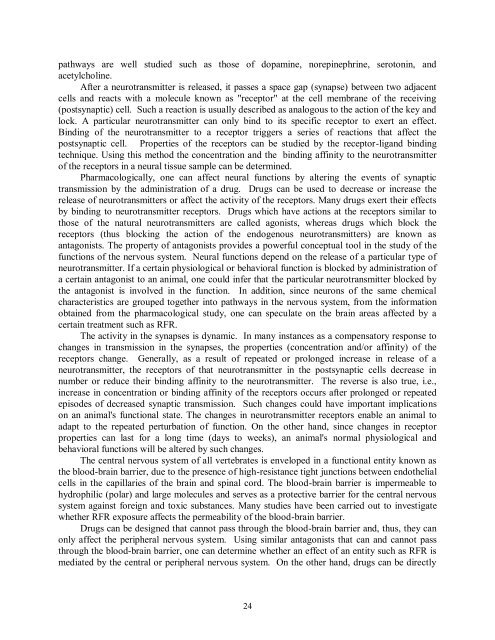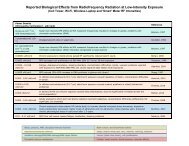Evidence for Effects on Neurology and Behavior - BioInitiative Report
Evidence for Effects on Neurology and Behavior - BioInitiative Report
Evidence for Effects on Neurology and Behavior - BioInitiative Report
Create successful ePaper yourself
Turn your PDF publications into a flip-book with our unique Google optimized e-Paper software.
pathways are well studied such as those of dopamine, norepinephrine, serot<strong>on</strong>in, <strong>and</strong><br />
acetylcholine.<br />
After a neurotransmitter is released, it passes a space gap (synapse) between two adjacent<br />
cells <strong>and</strong> reacts with a molecule known as "receptor" at the cell membrane of the receiving<br />
(postsynaptic) cell. Such a reacti<strong>on</strong> is usually described as analogous to the acti<strong>on</strong> of the key <strong>and</strong><br />
lock. A particular neurotransmitter can <strong>on</strong>ly bind to its specific receptor to exert an effect.<br />
Binding of the neurotransmitter to a receptor triggers a series of reacti<strong>on</strong>s that affect the<br />
postsynaptic cell. Properties of the receptors can be studied by the receptor-lig<strong>and</strong> binding<br />
technique. Using this method the c<strong>on</strong>centrati<strong>on</strong> <strong>and</strong> the binding affinity to the neurotransmitter<br />
of the receptors in a neural tissue sample can be determined.<br />
Pharmacologically, <strong>on</strong>e can affect neural functi<strong>on</strong>s by altering the events of synaptic<br />
transmissi<strong>on</strong> by the administrati<strong>on</strong> of a drug. Drugs can be used to decrease or increase the<br />
release of neurotransmitters or affect the activity of the receptors. Many drugs exert their effects<br />
by binding to neurotransmitter receptors. Drugs which have acti<strong>on</strong>s at the receptors similar to<br />
those of the natural neurotransmitters are called ag<strong>on</strong>ists, whereas drugs which block the<br />
receptors (thus blocking the acti<strong>on</strong> of the endogenous neurotransmitters) are known as<br />
antag<strong>on</strong>ists. The property of antag<strong>on</strong>ists provides a powerful c<strong>on</strong>ceptual tool in the study of the<br />
functi<strong>on</strong>s of the nervous system. Neural functi<strong>on</strong>s depend <strong>on</strong> the release of a particular type of<br />
neurotransmitter. If a certain physiological or behavioral functi<strong>on</strong> is blocked by administrati<strong>on</strong> of<br />
a certain antag<strong>on</strong>ist to an animal, <strong>on</strong>e could infer that the particular neurotransmitter blocked by<br />
the antag<strong>on</strong>ist is involved in the functi<strong>on</strong>. In additi<strong>on</strong>, since neur<strong>on</strong>s of the same chemical<br />
characteristics are grouped together into pathways in the nervous system, from the in<str<strong>on</strong>g>for</str<strong>on</strong>g>mati<strong>on</strong><br />
obtained from the pharmacological study, <strong>on</strong>e can speculate <strong>on</strong> the brain areas affected by a<br />
certain treatment such as RFR.<br />
The activity in the synapses is dynamic. In many instances as a compensatory resp<strong>on</strong>se to<br />
changes in transmissi<strong>on</strong> in the synapses, the properties (c<strong>on</strong>centrati<strong>on</strong> <strong>and</strong>/or affinity) of the<br />
receptors change. Generally, as a result of repeated or prol<strong>on</strong>ged increase in release of a<br />
neurotransmitter, the receptors of that neurotransmitter in the postsynaptic cells decrease in<br />
number or reduce their binding affinity to the neurotransmitter. The reverse is also true, i.e.,<br />
increase in c<strong>on</strong>centrati<strong>on</strong> or binding affinity of the receptors occurs after prol<strong>on</strong>ged or repeated<br />
episodes of decreased synaptic transmissi<strong>on</strong>. Such changes could have important implicati<strong>on</strong>s<br />
<strong>on</strong> an animal's functi<strong>on</strong>al state. The changes in neurotransmitter receptors enable an animal to<br />
adapt to the repeated perturbati<strong>on</strong> of functi<strong>on</strong>. On the other h<strong>and</strong>, since changes in receptor<br />
properties can last <str<strong>on</strong>g>for</str<strong>on</strong>g> a l<strong>on</strong>g time (days to weeks), an animal's normal physiological <strong>and</strong><br />
behavioral functi<strong>on</strong>s will be altered by such changes.<br />
The central nervous system of all vertebrates is enveloped in a functi<strong>on</strong>al entity known as<br />
the blood-brain barrier, due to the presence of high-resistance tight juncti<strong>on</strong>s between endothelial<br />
cells in the capillaries of the brain <strong>and</strong> spinal cord. The blood-brain barrier is impermeable to<br />
hydrophilic (polar) <strong>and</strong> large molecules <strong>and</strong> serves as a protective barrier <str<strong>on</strong>g>for</str<strong>on</strong>g> the central nervous<br />
system against <str<strong>on</strong>g>for</str<strong>on</strong>g>eign <strong>and</strong> toxic substances. Many studies have been carried out to investigate<br />
whether RFR exposure affects the permeability of the blood-brain barrier.<br />
Drugs can be designed that cannot pass through the blood-brain barrier <strong>and</strong>, thus, they can<br />
<strong>on</strong>ly affect the peripheral nervous system. Using similar antag<strong>on</strong>ists that can <strong>and</strong> cannot pass<br />
through the blood-brain barrier, <strong>on</strong>e can determine whether an effect of an entity such as RFR is<br />
mediated by the central or peripheral nervous system. On the other h<strong>and</strong>, drugs can be directly<br />
24



